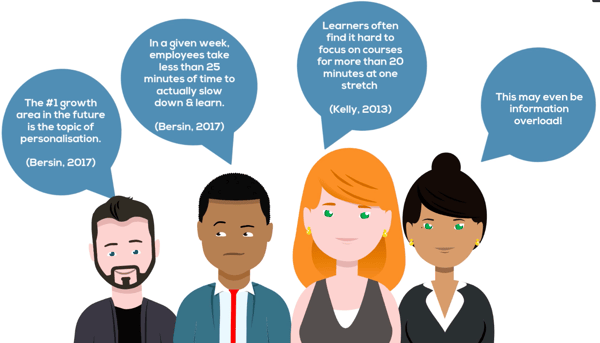There’s a saying that people quit their bosses, not their jobs.
However, a real reason people quit their jobs is a lack of learning and development opportunities. A survey conducted by Totaljobs, a leading UK recruitment agency, has found that 68% of employees changed their jobs in 2018 because of a lack of learning and development opportunities.
A recent study conducted by LinkedIn found similar results. According to the study, 94% of employees said they would stay at a company longer if it invested in their career development.
Career development is linked in many ways to learning. Today’s employees now want more learning and development opportunities to help them develop the skills they need to stay relevant in the workplace.
Beyond employee retention, learning is also important to stay relevant. The landscape of learning is changing rapidly. Digital disruption and the volatile business landscape drive an imperative to constantly update skills to remain relevant. Social, mobile and cloud connectivity are transforming how, where and when people learn, with the consumer experience reshaping workplace experience.
Build a Learning Culture
It’s therefore important to take a different approach to learning in your organisation. Beyond just providing learning opportunities, it’s essential to create a learning culture, shaping your organisation around a learning mindset that encourages growth and experimentation.
Not only does this build a compelling employee experience, but it also sets your organisation up for success. Employees hungry for learning and growth are also the ones who ensure that quality and excellence underlie every task, and they will challenge processes and innovate rather than keep to the status quo. This ultimately benefits the organisation.
However, building a learning culture is easier said than done. It’s not easy to convince employees of its benefits, especially when balanced against operational concerns and the lack of time employees have for learning.
Adult learners also have less time than ever to learn. Research has found that just 1% of the average adult’s workweek is available for learning. This is compounded by shrinking attention spans and the need for constant multi-tasking. Employees now want information in short, sharp bursts, and want to learn what they need, when they need it.

Short, sweet and effective – this is exactly what is needed in today’s world overflowing with data and distractions.
The Future of Learning
That’s why the future of learning is teeming with possibilities, especially with the advent of technology! There are a myriad of ways and learning tools to support learners - from video learning, structured learning, social learning, gamification and bite-sized mobile learning.
These approaches allow learners to learn the way they want to learn. Of all, mobile learning offers great potential for learning in the workplace.
Mobile learning is fast, accessible and most importantly, bite-sized. It’s also easily scalable for the entire organisation. This allows for a cost-effective and powerful learning solution to help organisations meet their learning needs.
This is in contrast to e-learning, which is often done on desktops and laptops. Mobile learning, on the other hand, can be done on the go. This is essential. Merrill Lynch has found that 82% of mobile learning actually takes place outside the office. With mobile learning, information can be accessed whenever and wherever it is needed. It also combines interactive elements that cannot be done with desk-bound e-learning.
This has contributed to the potential of mobile-learning. At the end of 2017, the mobile learning industry was estimated to be worth US$12.2 billion. By the end of 2020, it is estimated to be worth US$37.6 billion, greater than a 3-fold increase!
Skills to invest in
What then are the essential skills for learners today? There has been plenty of talk about the need for employees and learners to learn digital skills such as artificial intelligence, data analytics and even programming.
However, such skills only prepare for current needs. The World Economic Forum (2016) has found that the skills needed for the future are actually soft skills. The top 10 most important skills for the future were found to be predominantly soft skills - ranging from critical thinking to creative problem solving. A survey of CEOs in Asia also found that 72% believe soft skills are more vital than hard skills, making such development an economic and organisational priority.
As Albert Einstein once said, “Once we stop learning, we start dying.” It’s crucial to continue learning amid changes in the current landscape, and with its win-win benefits for organisations, its value definitely outweighs its investment.
Realyse – our mobile learning solution
That’s why we’ve built Realyse – our mobile learning app.
Realyse brings your organisation a library of content on the most important skills needed for the future – soft skills. Backed by Organisational Development (OD) principles and the science of developing effective individuals, our courses include critical thinking, creativity 101, problem solving and coaching amongst many others.
Try our free demo below, where we bring you three free courses, including a course on creative thinking.

